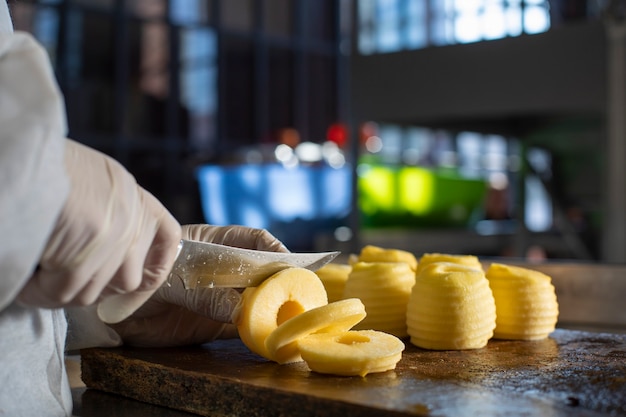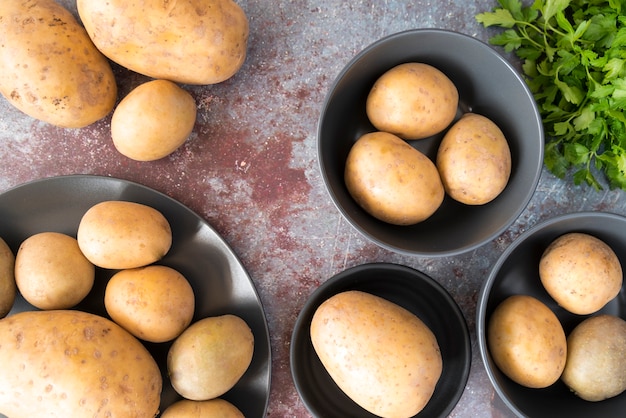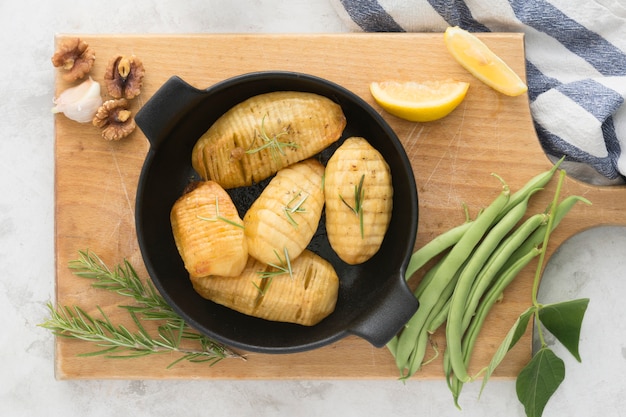Okay, let's be honest – potatoes are a kitchen staple, right? They're versatile, affordable, and undeniably delicious. But among the vast potato world, there's one variety that truly shines – the baby Dutch yellow potato. These little gems, with their buttery flesh and delicate skin, are a true culinary delight. I've always been a fan of potatoes, but these tiny guys have stolen my heart. They're so easy to cook, and they bring a delightful sweetness and tenderness to any dish. So, buckle up, fellow foodies, because we're diving headfirst into the world of baby Dutch yellow potatoes. Get ready for some serious potato love!
(Part 1) Picking the Perfect Spuds

The journey to culinary bliss starts with selecting the perfect potatoes. You'll usually find these little guys in bags, and you want to choose ones that are firm to the touch and free of any blemishes or soft spots. I always try to pick potatoes that are roughly the same size, which helps ensure even cooking. Remember, even a potato deserves a little TLC!
The Size Does Matter
You can often find baby Dutch yellows in a range of sizes, but for the most consistent results, I recommend sticking with the smaller ones – those that are around the size of a golf ball or smaller. These little guys cook faster and retain their delicate texture better than their larger counterparts.
Storing Your Potatoes
Once you've got your precious spuds, it's time to store them properly. A cool, dark, and well-ventilated place is ideal. I keep mine in a paper bag in my pantry, which helps prevent moisture buildup and keeps them from sprouting. You know, a little bit of care goes a long way!
(Part 2) A Primer on cooking techniques

Now, let's talk about the fun part: cooking. Baby Dutch yellow potatoes can be cooked in a variety of ways, each yielding a different texture and flavor.
Boiling
Boiling is a classic technique that creates a tender, fluffy potato.
1. The Basics
Bring a large pot of salted water to a boil, then add the potatoes. If you're boiling them for a recipe that calls for whole potatoes, you'll want to cook them until they're fork-tender, which typically takes around 15-20 minutes.
2. Timing is Key
However, if you're planning to mash or use them in a salad, you'll want to take them off the heat just before they become completely soft. The key is to have them tender but still slightly firm.
3. Don't Forget the Salt
Remember, a pinch of salt in the water helps season the potatoes from the inside out. It's a little trick I learned from my grandmother, and it makes a world of difference!
Roasting
Roasted baby Dutch yellow potatoes are a delicious and versatile side dish.
1. Prepping for the Oven
Preheat your oven to 400°F (200°C). Then, toss the potatoes with olive oil, salt, pepper, and any other desired spices. I love to add a little garlic and rosemary for extra flavor.
2. roasting time
Spread them in a single layer on a baking sheet and roast for about 25-30 minutes, flipping them halfway through. They should be golden brown and tender. The aroma alone is enough to make your mouth water!
3. Experiment with Flavors
For a more robust flavor, try adding garlic, rosemary, or thyme to your roasting mix. You can also experiment with different herbs and spices to find your perfect combination.
Pan-Frying
Pan-fried potatoes are a great way to get a crispy exterior.
1. Get that Sizzle
Heat a large pan over medium heat and add olive oil or butter. Once the oil is shimmering, add the potatoes.
2. Don't Overcrowd
Make sure they're in a single layer so they brown evenly. If you overcrowd the pan, they'll steam instead of crisp up.
3. Crispness is Key
Cook them for about 10-15 minutes, stirring occasionally, until they're golden brown and crispy.
4. Season with Care
Season with salt and pepper to taste. You can also add herbs or spices during the last few minutes of cooking. I sometimes add a pinch of smoked paprika for a little extra depth of flavor.
Microwaving
Microwaving can be a quick and easy way to cook baby Dutch yellow potatoes. It's perfect when you're short on time.
1. Prep and Cook
Prick the potatoes with a fork a few times, then microwave them on high power for about 5-7 minutes.
2. Check for Tenderness
The exact time will depend on the size of the potatoes and the power of your microwave. Check them periodically and cook until they're tender.
3. Simple Yet Effective
Microwaving is a great option for when you need a quick side dish or want to use the potatoes in a recipe that calls for cooked potatoes.
(Part 3) Recipes That Will Make Your Mouth Water

Now that we've covered the basics, let's dive into some delicious recipes that showcase the versatility of baby Dutch yellow potatoes.
1. Roasted Baby Dutch Yellow Potatoes with Herbs and Garlic
This recipe is a classic for a reason – it's simple, flavorful, and perfect for any occasion.
Ingredients:
1 pound baby Dutch yellow potatoes, scrubbed and halved or quartered
2 tablespoons olive oil
1 teaspoon salt
1/2 teaspoon black pepper
2 cloves garlic, minced
1 tablespoon chopped fresh rosemary
1 tablespoon chopped fresh thyme
Instructions:
1. Preheat oven to 400°F (200°C).
2. Toss the potatoes with olive oil, salt, pepper, garlic, rosemary, and thyme in a large bowl.
3. Spread the potatoes in a single layer on a baking sheet.
4. Roast for 25-30 minutes, flipping halfway through, until golden brown and tender.
2. Creamy Potato and Leek Soup
This creamy soup is a comforting and flavorful meal, perfect for a chilly evening.
Ingredients:
1 pound baby Dutch yellow potatoes, peeled and diced
1 large leek, white and light green parts only, chopped
4 cups vegetable broth
1 cup heavy cream
1/4 teaspoon salt
1/4 teaspoon black pepper
Fresh chives, for garnish (optional)
Instructions:
1. In a large pot or dutch oven, melt butter over medium heat.
2. Add the leeks and cook, stirring occasionally, until softened, about 5 minutes.
3. Add the potatoes, vegetable broth, salt, and pepper. Bring to a boil, then reduce heat and simmer for 15-20 minutes, or until the potatoes are tender.
4. Stir in the heavy cream and heat through.
5. Use an immersion blender or transfer the soup to a regular blender and blend until smooth.
6. Serve warm, garnished with fresh chives if desired.
3. Baby Dutch Yellow potato salad with Dijon Vinaigrette
This refreshing potato salad is a delightful summer side dish. It's light, flavorful, and perfect for a picnic or barbecue.
Ingredients:
1 pound baby Dutch yellow potatoes, cooked and chilled
1/2 cup chopped celery
1/4 cup chopped red onion
1/4 cup chopped fresh parsley
Dijon Vinaigrette:
1/4 cup Dijon mustard
1/4 cup white wine vinegar
1/2 cup olive oil
1 teaspoon salt
1/2 teaspoon black pepper
Instructions:
1. Combine the potatoes, celery, red onion, and parsley in a large bowl.
2. In a separate bowl, whisk together the Dijon mustard, white wine vinegar, olive oil, salt, and pepper until emulsified.
3. Pour the vinaigrette over the potato mixture and toss to combine.
4. Refrigerate for at least 30 minutes before serving.
4. Potato and Chorizo Hash with Fried Eggs
This hearty and flavorful hash is a great breakfast or brunch option. It's a real crowd-pleaser, and it's perfect for a weekend brunch.
Ingredients:
1 pound baby Dutch yellow potatoes, diced
1/2 pound chorizo, crumbled
1/2 cup chopped onion
1/4 cup chopped bell pepper
1/4 cup chopped fresh cilantro
2 eggs
Salt and pepper to taste
Olive oil, for cooking
Instructions:
1. Heat a large skillet over medium heat and add olive oil.
2. Add the potatoes, chorizo, onion, and bell pepper. Cook, stirring occasionally, until the potatoes are golden brown and the chorizo is cooked through, about 15-20 minutes.
3. Stir in the cilantro and season with salt and pepper to taste.
4. While the hash is cooking, heat a small pan over medium heat and add olive oil. Crack the eggs into the pan and cook until the whites are set and the yolks are still runny, about 2-3 minutes.
5. Serve the hash topped with the fried eggs.
5. Simple Baby Dutch Yellow potato pancakes
These potato pancakes are a quick and easy treat that's perfect for any occasion. They're a great way to use up leftover potatoes and are perfect for a quick snack or side dish.
Ingredients:
1 pound baby Dutch yellow potatoes, grated
1/2 cup finely chopped onion
1 egg
1/4 cup all-purpose flour
1/4 teaspoon salt
1/4 teaspoon black pepper
Olive oil, for cooking
Instructions:
1. In a large bowl, combine the grated potatoes, chopped onion, egg, flour, salt, and pepper.
2. Heat a large skillet or griddle over medium heat and add olive oil.
3. Drop spoonfuls of the potato mixture into the hot oil. Cook for about 3-4 minutes per side, or until golden brown and crispy.
4. Serve hot.
(Part 4) Unleashing Your Culinary Creativity
The beauty of baby Dutch yellow potatoes is that they lend themselves to endless culinary possibilities.
1. Embrace Experimentation
Don't be afraid to experiment with different flavors and ingredients. You can add spices like cumin, paprika, or chili powder to your roasting mix, or toss them with fresh herbs like dill, parsley, or chives. The possibilities are endless!
2. Texture Twists
For a fun twist, try adding chunks of bacon or sausage to your roasted potatoes. It adds a smoky, savory flavor that complements the potatoes perfectly.
3. Global Inspiration
Get inspired by cuisines from around the world. You could make a Spanish-style potato salad with smoked paprika and olives, or a Greek-inspired dish with feta cheese and oregano.
4. Play with Colors
Baby Dutch yellows are naturally a pale yellow, but you can add pops of color with ingredients like red bell peppers, purple onions, or green beans. This not only makes your dish visually appealing but also adds another layer of flavor.
(Part 5) Tips and Tricks for Cooking Perfection
As with any culinary pursuit, a few tricks of the trade can elevate your baby Dutch yellow potato game.
1. The Art of Salting
Don't skimp on the salt. It's essential for bringing out the flavors of the potatoes and adding depth to your dishes. Remember, salt is your friend!
2. Temperature Matters
When roasting, make sure your oven is preheated to the correct temperature. This ensures even cooking and prevents the potatoes from becoming mushy.
3. Embrace the Pan
Use a pan that's large enough to accommodate the potatoes in a single layer. This helps them brown evenly and prevents them from steaming.
4. Don't Overcrowd
If you're pan-frying, don't overcrowd the pan. The potatoes need space to brown properly. If necessary, cook them in batches.
5. The Importance of Cooling
Once you've cooked the potatoes, let them cool slightly before using them in a recipe. This allows the starch to settle, resulting in a firmer texture.
(Part 6) Storing Your Potatoes
Proper storage is crucial for keeping your potatoes fresh and flavorful.
1. The Ideal Conditions
Store them in a cool, dark, and well-ventilated place. I keep mine in a paper bag in my pantry, which helps prevent moisture buildup and keeps them from sprouting.
2. Avoiding the Fridge
Do not store baby Dutch yellow potatoes in the refrigerator. The cold temperature can cause them to become starchy and lose their flavor.
3. The Shelf Life
When stored properly, baby Dutch yellow potatoes can last for several weeks. If you notice any signs of spoilage, such as soft spots or sprouts, discard the potatoes.
(Part 7) Baby Dutch Yellow Potatoes: A nutritional powerhouse
Beyond their deliciousness, baby Dutch yellow potatoes are a surprisingly nutritious food.
1. A Source of Vitamins and Minerals
They're a good source of vitamin C, vitamin B6, potassium, and fiber. They also contain antioxidants, which can help protect against cell damage.
2. A Good Source of Carbohydrates
Potatoes are a good source of complex carbohydrates, which provide your body with energy. They also contain resistant starch, a type of fiber that may help regulate blood sugar levels and improve digestive health.
3. Part of a Healthy Diet
When enjoyed as part of a balanced diet, baby Dutch yellow potatoes can be a nutritious and satisfying addition to your meals.
(Part 8) FAQs
1. What makes baby Dutch yellow potatoes different from other potatoes?
Baby Dutch yellow potatoes are known for their buttery texture, delicate skin, and slightly sweet flavor. They're also smaller in size than other varieties, which makes them easier to cook and perfect for using in salads, soups, or as a side dish.
2. Can I substitute baby Dutch yellow potatoes with another variety?
While you can substitute them with other potatoes, the results may vary. If you're looking for a similar texture and flavor, try using yukon gold potatoes. However, if you need a starchy potato, you might want to use russet potatoes.
3. How do I know if my potatoes are bad?
Potatoes that are bad will often have soft spots, sprouts, or a greenish tinge. If you notice any of these signs, discard the potatoes.
4. Can I freeze baby Dutch yellow potatoes?
It's not recommended to freeze baby Dutch yellow potatoes, as they can become mushy when thawed. However, you can freeze them after they've been cooked.
5. Are baby Dutch yellow potatoes good for weight loss?
Baby Dutch yellow potatoes can be part of a healthy weight loss diet, but it's important to eat them in moderation and choose healthy cooking methods. They're a good source of fiber and nutrients, but they also contain carbohydrates.
In conclusion, baby Dutch yellow potatoes are a culinary treasure that deserves a place in your kitchen. They're versatile, delicious, and surprisingly nutritious. So, go forth and experiment with these little gems. You might just discover your new favorite potato! Happy cooking!
Everyone is watching

How to Cook Frozen Lobster Tails Perfectly: A Step-by-Step Guide
RecipesLobster. Just the word conjures up images of lavish meals, special occasions, and a taste of luxury. But let's...

Pigs in a Blanket Cooking Time: How Long to Bake for Perfect Results
RecipesAh, pigs in a blanket. Just the name conjures up images of those delightful little parcels of crispy pastry en...

Pork Fillet Cooking Time: How Long to Cook It Perfectly
RecipesPork fillet, or tenderloin as it's sometimes called, is a real favourite in our house. It's so versatile, and...

The Ultimate Guide to Tender, Juicy Pulled Pork
RecipesRight, let's talk pulled pork. It's one of those dishes that just screams "comfort food," doesn't it? I mean...

The Ultimate Guide to Cooking Sweet Potatoes: From Roasting to Mashing
RecipesSweet potatoes. Just the name conjures up images of warm, comforting dishes, bursts of vibrant color, and a to...
